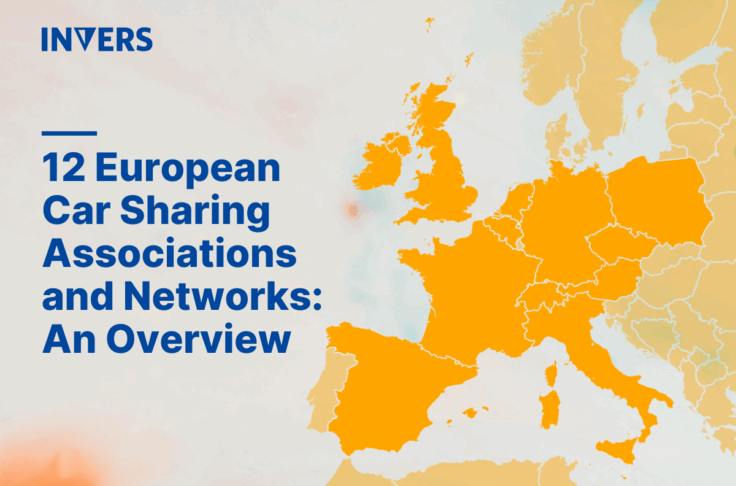Managing the Challenges of Running a Micromobility Program – NABSA Discussion Panel Recap
Summary
INVERS joined a discussion panel on challenges faced by micromobility systems at NABSA’s (North American Bikeshare and Scootershare Association) virtual conference at the end of October. “Adapt and Overcome: Managing the Challenges of Running a Micromobility Program” featured experts from four different organizations offering useful insights and perspectives on challenges faced by the industry.
Over the last several years, shared micromobility systems all over the world had to adapt to and overcome challenges caused by their own growth as well as the ongoing pandemic. Operators are feeling pressure to deal with improperly parked e-scooters, growing fleets with a variety of vehicles are making it harder to aggregate and use vehicle data, cities are learning how to properly regulate shared mobility programs, and the industry is becoming aware of a lack of diversity in its own workforce. NABSA’s panel shared their thoughts on all four of those micromobility program challenges:
Improperly parked scooters: reality and perceptions
Anne Brown, Assistant Professor in Community and Regional Planning at the University of Oregon, kicked the presentation off by sharing the results of her team’s research on improperly parked scooters based on observations of 869 bikes and e-scooters and 2659 motor vehicles in five American cities: Austin, TX, Portland, OR, San Francisco, CA, Santa Monica, CA, and Washington, DC. The researchers wanted to learn why improper scooter parking occurs and what can be done about it, and concluded that:
- The public as well as people in the industry vastly over-estimate the rate of improper parking; while 40% of the public thinks that more than 30% of scooters are misparked, the reality is that less than 1% of scooters (8 out of 869 in the study) are improperly parked.
- Motor vehicles are left parked improperly at a much greater rate than e-bikes or scooters; nearly 25% of observed motor vehicles were not parked properly.
- People will follow scooter and bike parking rules if they are made obvious and natural. Improperly parked scooters are often the result of the public not knowing what the rules are, or their intuition not lining up with regulations; for example in Cologne tipped overs scooters are considered OK by the city’s rules though most people would say that a scooter lying anywhere on the sidewalk is improperly parked, while in some cities scooters are not allowed to be parked in bike racks which to most seems like a natural place to park a scooter.
- Most people think that tidy parking is proper parking. For example, they may perceive three neatly arranged scooters to be properly parked even if they were left where the rules prohibit, while three messily arranged scooters left in an area where scooter parking is allowed may be perceived to be improperly parked.
- Implementing clear parking infrastructure like corrals and designated parking spaces is a certain way to get the public to put away their shared scooters properly. Provide parking and scooter users will use it.
Vehicle data: importance and difficulties
In an increasingly competitive market, shared micromobility operators are turning to multi-modal (mixed vehicle) fleets to differentiate themselves and to meet customer demand. However, connecting multi-modal fleets to get useful and actionable data from all the vehicles can be difficult. Developers need to create and maintain APIs to pull and standardize data from aftermarket telematics hardware installed in vehicles or from the vehicles OEM telematics units.

Valdrin Shala, INVERS Strategic Product Manager, presented OneAPI; an API aggregator which standardizes, normalizes, and cleans data to provide developers generic and easy to work with values. With OneAPI, mobility operators more easily gain insights into data to help run and improve operations, as well as data they can share with cities to improve accessibility and equity.
Managing challenges faced by cities
We’ve recently discussed how regulations are increasing for shared micromobility operations, so it’s interesting to get insights on the city/operator relationship from the city’s point of view. Meg Young, Shared Mobility Coordinator at Baltimore City Department of Transportation, presented the challenges and solutions found from running shared mobility programs in Baltimore.
The city’s Department of Transportation has two main goals when it comes to their shared e-scooter program: increasing the equity of access and continuing the growth of ridership. Their motivation for increased equity comes from the fact that a large percentage of families in several Baltimore neighborhoods do not have access to vehicles. Those neighborhoods were initially underserved by shared mobility as well, but the city started solving this problem through deployment requirements as well as discounted memberships for lower income families. The map image below shows the impact these initiatives had on equitable access in just one year.

While the city does not own any of the shared micromobility vehicles deployed in Baltimore, vandalism is still a big concern to them as it jeopardizes the success of their program. To solve this problem, Baltimore started to work with local community centers and leaders to bring attention to vandalism and to mediate restorative response sessions instead of making arrests. The city also works to ensure smooth operations by working with universities, hospitals, stadiums and other partners to set policies, make sure parking and deployment rules are understood and evenly applied to all operators, and to ensure large events get additional support.
Diversity challenges
Shared mobility is a relatively new industry that does not yet have career pathways set by norms and tradition, which presents an opportunity for diversity in its workforce and fairness in its career paths. Carniesha Kwashie, Chief Equity and Strategy Officer at Bicycle Transit Systems, presented tools and systems used by Bike Transit to set clearer career pathways for Black, Indigenous People of Color (BIPOC) to advance in the shared mobility industry. This will have an impact not only internally on the shared mobility organizations themselves, but also on the industry’s diverse customers who will be better able to see themselves reflected in the industry’s actions and services.
Bike Transit uses a framework called Awake to Woke to Work to build a race equity culture and implement Diversity, Equity, Inclusion, and Justice (DEIJ) driven practices long term. The framework consists of 5 steps:
- Establishing a shared vocabulary to create a common language around DEIJ.
- Identifying DEIJ champions at the board and senior leadership levels.
- Demonstrating how DEIJ connects to Bike Transit’s mission, vision, values and strategy.
- Opening a continuous dialogue about DEIJ work and cultivating opportunities for colleagues to learn about and discuss DEIJ.
- Disaggregating data to identify inequities and outcomes gaps.
The discussion ended with a Q&A segment and a recap of poll questions asked to the audience. We’re looking forward to participating in-person next year in Guadalajara, and in the meantime all NABSA members can access the recording of this session as well as the entire conference archive here.


